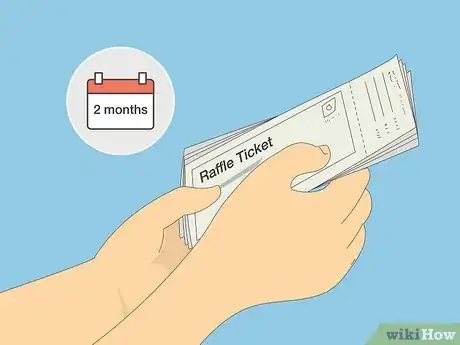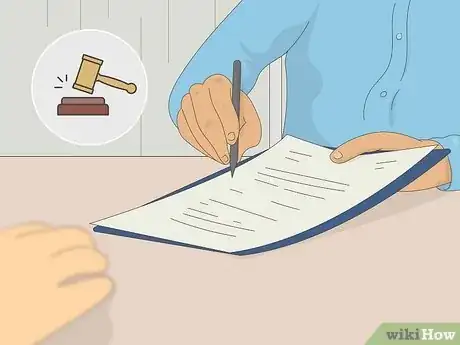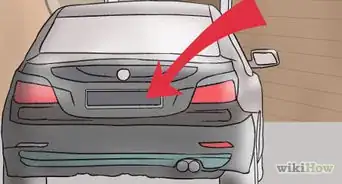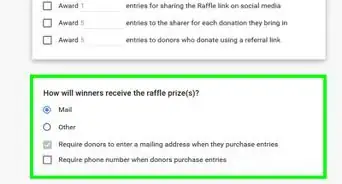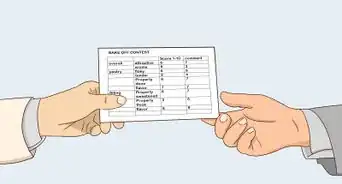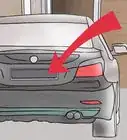This article was co-authored by wikiHow staff writer, Christopher M. Osborne, PhD. Christopher Osborne has been a wikiHow Content Creator since 2015. He is also a historian who holds a PhD from The University of Notre Dame and has taught at universities in and around Pittsburgh, PA. His scholarly publications and presentations focus on his research interests in early American history, but Chris also enjoys the challenges and rewards of writing wikiHow articles on a wide range of subjects.
There are 13 references cited in this article, which can be found at the bottom of the page.
This article has been viewed 89,981 times.
Learn more...
Buying a car raffle ticket is a fun way to take a chance on winning a big reward—namely, a shiny new car. But, if you’re the one running the car raffle, you have to navigate lots of legal red tape while also selling enough tickets to turn a profit. To help out, we’ve provided the key guidance you need in order to make your car raffle both profitable and fun. So let’s get ready to raffle!
Things You Should Know
- Follow the rules and regulations for a charity raffle in your area. It's best to consult an attorney as there can be many requirements and lots of red tape.
- Ask a local dealership to donate a vehicle that will appeal to your ticket buyers. Offer lots of free marketing in return.
- Advertise widely and sell as many tickets as you can. Aim to make twice as much as the car's value from ticket sales.
- Do a live drawing to announce the winner. Don't forget to handle the paperwork and taxes once the car is raffled off.
Steps
Making Sure Your Raffle Is Legal
-
1Consult an attorney before setting up a charity raffle. Some government authorities have strict rules regulating raffles, while others have none at all. And, even when raffles are legal, there are usually mountains of exceptions and qualifications to the rules and requirements. So your best bet is to find a lawyer in your area who has experience dealing with raffles and other fundraisers typically run by charities.[1]
- Because it is a game of chance that requires you to pay to enter, raffles are regulated as a form of gambling in many jurisdictions.
- Many U.S. states limit raffles to established (not brand-new) charitable organizations, churches, or volunteer organizations.
- Check whether you need to pay taxes on the vehicle and whether you need to register it before the raffle.
- You may need a gaming license or similar state registration to hold a raffle. For example, in California, you must register your raffle with the state’s Attorney General.[2]
-
2Check the law before selling your car by non-charity raffle. Many government authorities that permit raffles limit them to clearly-defined non-profit, charitable organizations. Therefore, it’s a good idea to check with a lawyer first, and to have some other creative ways to sell your car in mind just in case non-charity raffles are considered illegal gambling.[3]
- You might want to hold your car raffle online, on a dedicated raffle website or on a social media platform (like Facebook), but the legality of this will still be governed by the raffle rules where you live.
Advertisement -
3Set rules for your raffle that follow the law where you live. Consult with an attorney, or with someone from the relevant government agency that authorizes raffles, to establish the rules for your raffle. Make sure these rules are clearly spelled out, in writing, and are available to every potential ticket purchaser—again, according to the governing laws where you live. Your rules might include items like the following:[4]
- Listing a minimum age for ticket purchasers.
- Requiring purchasers to be a resident of the state or country where you’re holding the raffle.
- Setting a maximum number of tickets available to a single purchaser.
- Prohibiting anyone closely affiliated with your organization from buying tickets.
- Detailing how taxes will be handled (for instance, stating that the winner will be responsible for all taxes).
Getting a Car to Raffle for Charity
-
1Seek out a donated car, especially from a local car dealership. Raffling a donated car from a local dealership is definitely the best case scenario. Getting the car donated vastly increases your potential profit, and working with an established dealership can increase the raffle’s name recognition, advertising, and excitement factor.[5]
- If you can’t get a donated car from a dealer, aim to get donations to cover the cost of buying a car to raffle. In other words, recruit people and organizations to donate to your organization so you can use the proceeds to buy a car.
-
2“Sell” the potential donors on the benefits of taking part. If you’re aiming to get a dealer to donate a car, offer lots and lots of positive and high-visibility advertising—that’s what will make the donation worth the hit to their bottom line. Also, whether you’re soliciting a car dealer or other individuals or businesses for donations, have info like the following ready to share:[6]
- Your organization’s background. Provide details on when you were established, how much you have raised for your cause, etc.
- How you will showcase your sponsors. For example, you might tell the dealer: “We’ll feature your dealership’s name prominently in all marketing materials and on the individual tickets—that’s a lot of free advertising for you!”
- How you will monitor and evaluate the raffle. For example, does your organization have an accountant or bookkeeper who will oversee the raffle and keep track of the money raised?
- How you will use the money raised. For example: “All money raised will directly support families of patients in Children’s Hospital, and I know that’s a cause that’s near and dear to your heart.”
-
3Choose a car that will appeal to your potential ticket buyers. While you might assume you should always go with a luxury car, the best car to raffle is one that matches the demographics of your audience. Think about who is likely to support your cause and what type of vehicle they’re most likely to be interested in winning. If that means raffling a van instead of a coupe, so be it![7]
- For example, if you are an environmental charity, then you might want to raffle a hybrid vehicle.
- Or, If your target audience is young professionals, then you might want something more sporty.
- However, if your audience consists mostly of families, then you may choose to raffle a minivan or family-friendly SUV.
Running a Successful Charity Raffle
-
1Set a budget based on your profit, expense, and ticket estimates. Several elements come together in order to create a budget for a charity raffle:
- How much money you hope to make. For a charity car raffle, a reasonable goal is to make twice as much as the sale price of the car—for instance, to make $76,000 USD by raffling a $38,000 USD car.
- The costs associated with printing, advertising, etc. Since charity car raffles rely heavily on volunteers (and, hopefully, a donated car), your expenses should be limited to the cost of printing tickets and for advertising.[8]
- How many tickets you think you can sell. Base this on the number of volunteers you have to sell tickets as well as the size of your target community. Print up about 33% more tickets than your estimate just in case!
-
The price to charge per ticket. Car raffle tickets usually run in the $25-$50 USD range. Use your profit goal, expenses, and anticipated ticket sales to make the calculation:[9]
- For instance, say your profit goal is $76,000 USD, your expenses for printing and advertising are $4,000 USD, and your ticket sale estimate is 2,300 (out of 3,400 printed). In order to make $80,000 USD (profit plus expenses), you’ll need to sell your tickets at $35 USD apiece.
-
2Offer additional, smaller donated prizes as well. You can increase interest in your raffle if you also offer smaller prizes. This way, more than one person is a “winner” at the raffle. You can offer prizes like cash awards, vacation getaways, electronics (flat screen TVs, etc.), gift baskets, and gift certificates to local retailers and restaurants.[10]
- Approach the process of getting prizes (or cash) donated from businesses like you did getting the car donated. Craft a personalized “pitch” for each business that lays out your charity’s mission and specifies how making a donation will materially benefit them (such as through the advertising you’ll provide for them).
-
3Have your tickets ready to sell at least 2 months before the drawing. You need to give yourself a fair amount of time to sell several thousand raffle tickets, and 2-3 months is a good estimate for a car raffle. While you can print out the tickets yourself, it’s probably a better use of your time to have a professional printer create the tickets for you.[11]
- The tickets should contain the name of your organization, any sponsors, and the time, date, and location of the raffle. Make sure to include the price, too!
- Ensure that the tickets are individually numbered, both on the section you’ll keep for the drawing and the section the buyer keeps.
-
4Advertise your raffle and sell tickets widely yet strategically. It’s important to cast a wide net with your sales and advertising, but not to waste time and money in the process. Make sure that the people who are most likely to buy your car raffle tickets are also the people most likely to encounter your advertisements and sales force.[12]
- Include relevant info (ticket cost, drawing date, major sponsors, etc.) plus a prominent picture of the car in your advertising.
- Advertise the raffle on your organization’s website and social media accounts, and also post flyers on community bulletin boards (at the library, grocery store, etc.).
- Put together a motivated, trustworthy volunteer sales force and give each team member a (reasonable) set number of tickets to sell by the deadline.
- Set up sales tables, staffed by energetic, knowledgeable volunteers, at high-traffic areas such as outside major retailers that see a lot of foot traffic. Get permission first, of course.
-
5Turn the actual raffle drawing into a fun spectacle. You want the drawing to be a “can’t miss” event, even if the winners don’t actually have to be present. Pick a drawing location that can hold a lot of people—since you’re raffling a car, the donating dealership is a great choice. Here are some ways you can ramp up the fun factor from there:[13]
- Invite the news media. Ask your local newspapers, radio stations, and television stations to attend the drawing.
- Ask a local celebrity to draw the winning ticket. This can entice the media and the public to attend. Mention this person in your advertising.
- Take pictures of the raffle. Post these to your website and social media accounts, and send them to local news media as well.
- Make the drawing itself extra flashy! Have the people involved in drawing the winning ticket dress up, have music, balloons, and confetti at the ready, and use a big raffle drum to mix up the tickets before pulling one.
-
6Make sure to handle the legal and tax stuff after the raffle. Unfortunately, it’s not as easy as just handing over the keys to the lucky winner! You may have to submit a financial statement after the raffle, and you’ll almost certainly have to file tax papers and pay taxes on the car. Here again, it pays to have the help of a knowledgeable attorney.[14]
- The process of transferring the car’s title (and thus legal ownership) to the winner varies based on where you live. Expect some paperwork and fees—but, if you’re lucky, you might be able to complete the process online![15]
- In the U.S., you may have to file a W-2G form with the IRS if the value of the car was 300 times the price of the raffle ticket.[16]
- You will also have to withhold U.S. federal taxes on the car if it is worth more than $5,000 and more than 300 times the ticket price. You can handle withholding taxes in a few ways:[17]
- Ask the winner to hand over the taxes before you turn over the car. If they can’t or won’t do this, let the winner choose to take a cash equivalent and deduct the taxes from that amount.
- Increase the prize amount to include the taxes due—in other words, the winner gets both the car and the amount of money required to cover the taxes.
Community Q&A
-
QuestionHow to insure car until it is raffled?
 Community AnswerTalk to an insurance agent about short-term insurance.
Community AnswerTalk to an insurance agent about short-term insurance. -
QuestionWhat are the rules for raffling a personal vehicle?
 Community AnswerMake sure the title is clear and ready to be signed over to the winner. Also be prepared to report the value of the car for tax purposes.
Community AnswerMake sure the title is clear and ready to be signed over to the winner. Also be prepared to report the value of the car for tax purposes.
References
- ↑ https://www.texasattorneygeneral.gov/divisions/financial-litigation/charitable-trusts/charitable-raffles-and-casinopoker-nights
- ↑ https://oag.ca.gov/charities/raffles
- ↑ https://www.sos.state.co.us/pubs/bingo_raffles/files/PlanningARaffle.pdf
- ↑ https://nonprofitquarterly.org/how-to-do-a-raffle/
- ↑ https://www.stepbystepfundraising.com/how-to-organize-a-raffle-fundraiser/
- ↑ https://nonprofitquarterly.org/how-to-do-a-raffle/
- ↑ https://www.stepbystepfundraising.com/how-to-organize-a-raffle-fundraiser/
- ↑ https://nonprofitquarterly.org/how-to-do-a-raffle/
- ↑ https://www.theclassroom.com/how-to-run-a-5050-raffle-fundraiser-12083382.html
- ↑ https://www.autoblog.com/2017/02/28/how-to-host-car-show-fundraiser/
- ↑ http://www.stepbystepfundraising.com/how-to-organize-a-raffle-fundraiser/
- ↑ https://nonprofitquarterly.org/how-to-do-a-raffle/
- ↑ https://nonprofitquarterly.org/how-to-do-a-raffle/
- ↑ https://www.michigan.gov/cg/raffles
- ↑ https://www.dmv.ca.gov/portal/vehicle-registration/titles/title-transfers-and-changes/
- ↑ https://www.irs.gov/pub/irs-tege/notice_1340.pdf
- ↑ http://www.nonprofitaccountingbasics.org/special-events-fundraising/raffles-right-way








